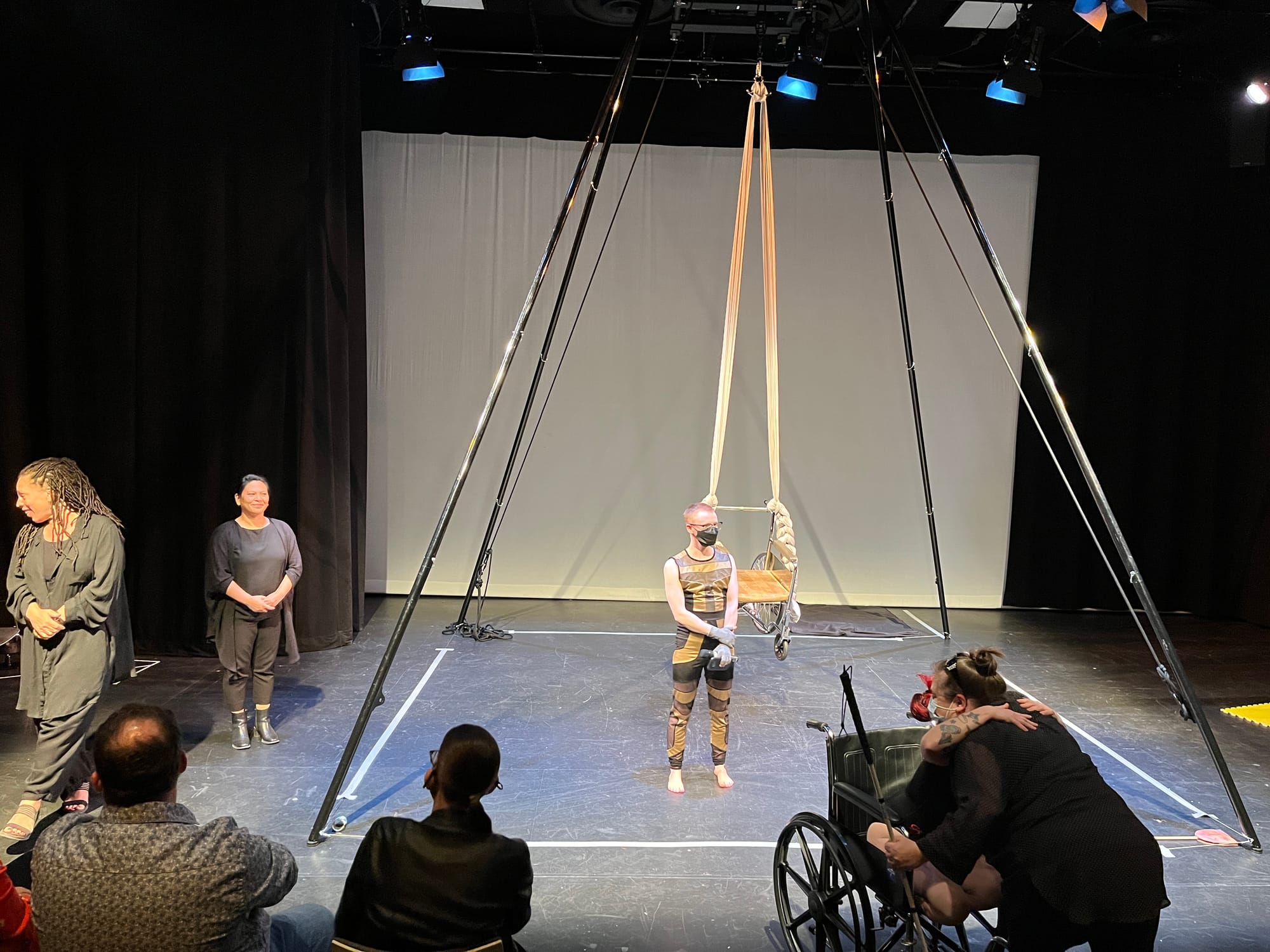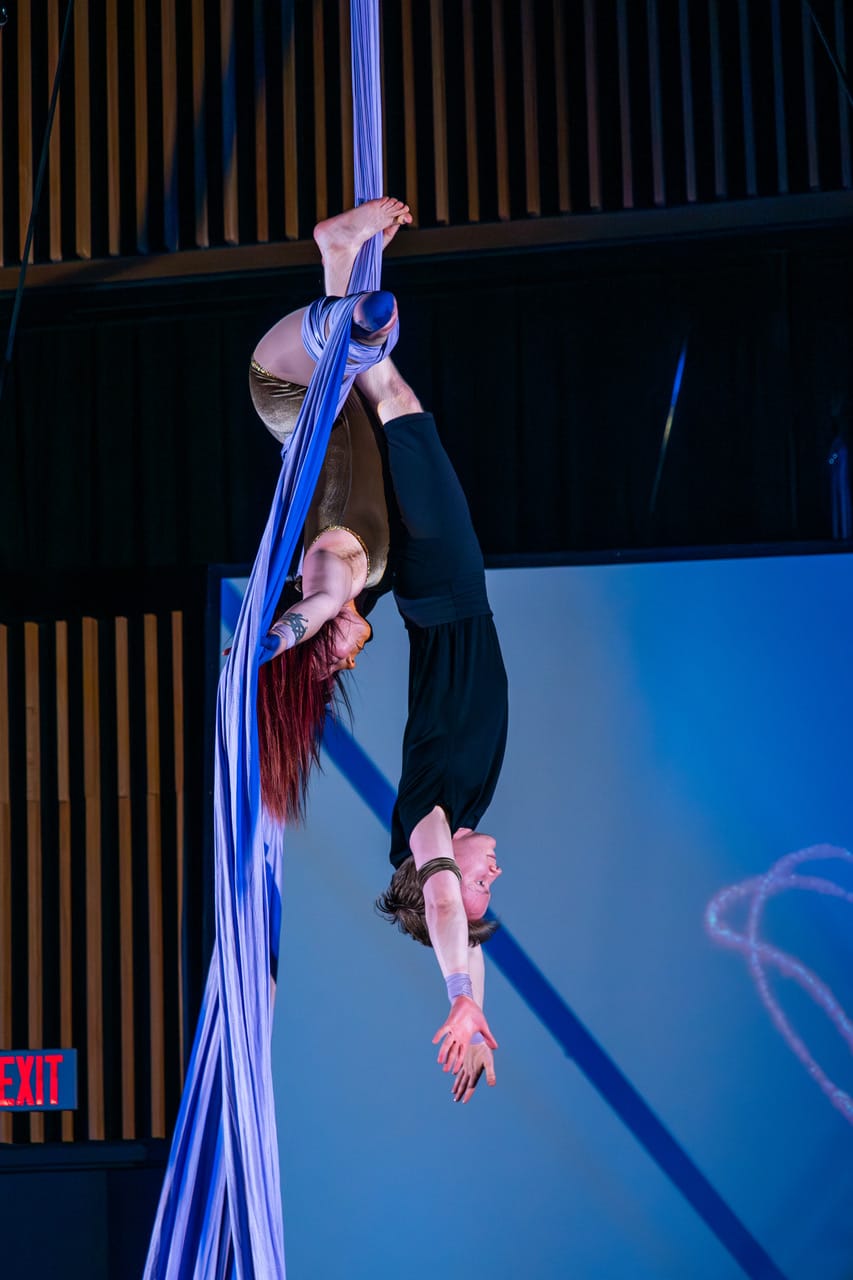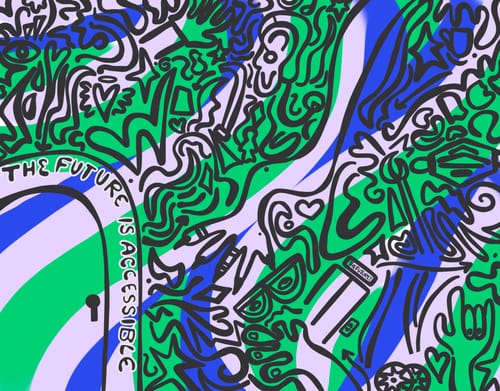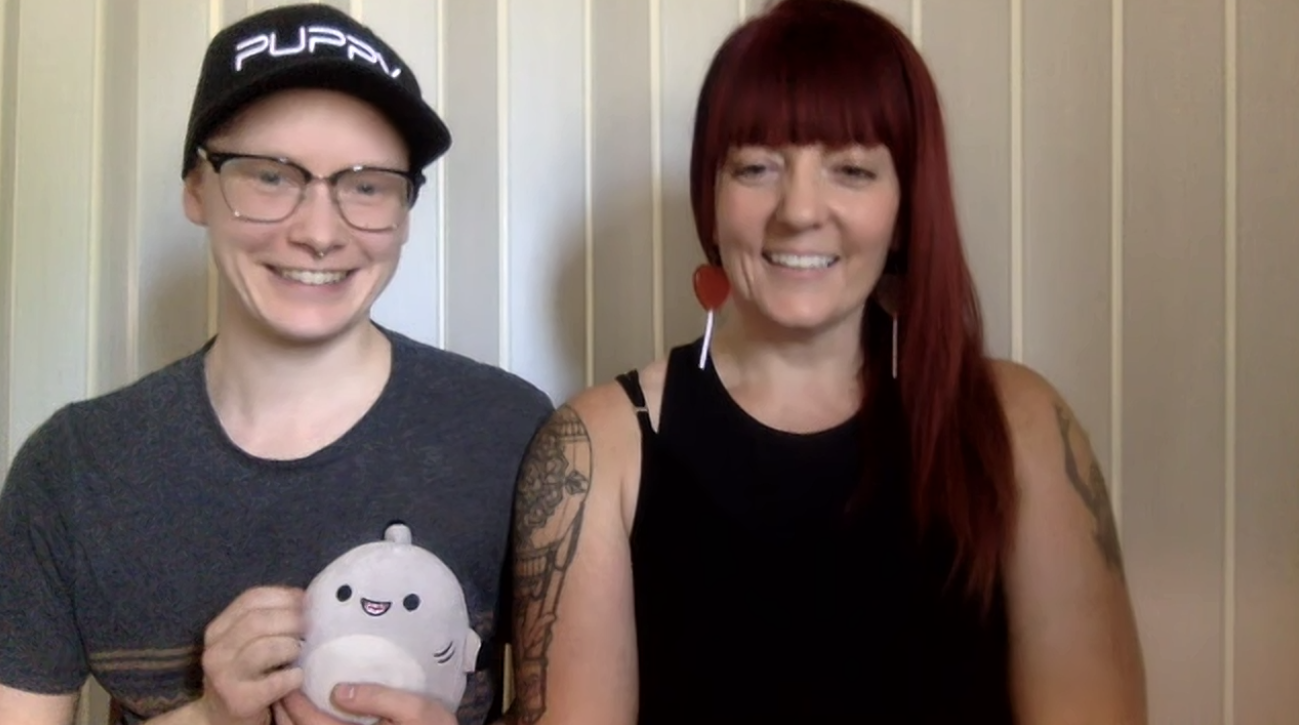Instead of having it from the perspective “it must be this”, really going with the essence helps me be more flexible in things that can't be rigid.
Lindsay: For the reader who might not know, can you describe what FOLDA is?
Erin: It stands for the Festival of Live Digital Art. I cannot say enough about how wonderful that team is: really prioritizing access and creating a space that allows artists to push boundaries and explore, without the pressure of it being a finished product.
Maxime: There's what they call the “Alpha” phase, which is more the exploration and research phase and wanting to ask audience feedback on where the work is at. Then the “Beta” phase where the exploration is going with a little bit more shape to it and then there's the “Go” phase, which is the more polished version.
Erin and I did the Alpha phase last year, which ended up being more of a Beta phase, and this year, we were supposed to be doing a Beta phase, which ended up being more like an Alpha phase, so we switched things around. The FOLDA team supported us in ways which is really a collective sense of holding each other, and that was just so lovely.
Lindsay: What was that like, flipping from beta to alpha or alpha to beta?
Maxime: Our original vision was an extension of feedback that we got from last year’s InterComplementary Elements.
We were experimenting with creative accessibility and how to make that functional for audiences, with the idea that we strive to create environments where audiences can have a fuller experience, as opposed to the same experience.
There are access needs that may collide, and there's some access that will function for some folks but will not function for other folks, so we were researching how to make creative access functional in ways that creates a fuller experience for as many people as possible.
Last year, we focused on creative access for blind and partially-sighted audiences, knowing that accessibility often goes beyond the intended audiences and we worked a lot with creative description and various forms of creative descriptions.
Amy Amantea, our blind consultant, started having some ideas of how to incorporate creative access for Deaf and hard-of-hearing folks but access takes time, and we couldn't do it all, and so instead of trying to cram everything in, we were like, “Okay, let's do the best we can.”
But we were ambitious, and we wanted the audience to have a fuller experience from what started as nothing, so we were creating a full show. That was a lot to take on, but we were really passionate about this.
Erin: Some of the feedback we got from Deaf audiences and our Deaf consultant, Sage Lovell, informed the direction that we decided to go this year. The feedback was that the storytelling aspect didn't come through with the hearing ASL interpreters interpreting because it was the visual descriptions as well as the story.
We received funding through the Canada Council to do research with Gaitrie and Jaideep, as well as Andrew, and then FOLDA asked us to come back, and the timing kind of all lined up. We thought, “okay, we'll put the focus this year on access for Deaf and hard-of-hearing folks, and try to incorporate as much other access as we can.”
Our goal was to explore ASL in the air, which meant Jaideep learning aerial arts and figuring out that process, and then Andrew creating music and creating the tonoscope, which gives the visual representation of his music. We also wanted to explore more engaging ways of using technology.

Lindsay: What’s one thing that surprised you about this show?
Erin: The show was Saturday and we found out Friday that Gaitrie couldn't come because of access needs. One of our main questions had been: how can we make digital technology more engaging through live performance?
What came out of that was an incredible amount of learning, because figuring out we only had two interpreters (there is a big shortage of ASL interpreters) - we had two for the live stream, for the live audience, for Jaideep, Gaitrie online - so figuring all of that out.
How is the live stream going to know to shift to Gaitrie or Jaideep when they're sharing all of these things? We had to sort out a whole new process in a very short amount of time.
Lindsay: That's not a pivot, that's a crisis!
Erin: Yeah, there was a moment that I was just like: “What? Okay.”
Maxime: We've been learning a lot. Our work just keeps embedding new learnings and new information to carry on to the future.
It just all translates to where we're going and as much as we learned a lot from InterComplementary Elements, we were still trying to figure out, the two of us, how to work in ways that respected our access needs.
We were striving to go there, but we weren't there yet. I feel like this year, putting our access needs first, really helped navigate the incredible amount of changes and intensity that happened because we checked in with ourselves first and as a group, and we really held each other in a collaborative way.
When we felt stuck we were like: “We don't think we can take on more with our brain,” and we're like, “actually, there are other brains in the room that can take this on,” so we gave a call to someone on the team, and we were like, “Okay, we're stuck. Here's where we're at. Do you have any ideas?”
Then ideas would be brought to the table, and we would bounce off each other and be like, “What about this? What about that? And, it would get flowing again in a way that felt like it was manageable, and also having this trust and care within the group really made it possible for us to respect our own access needs while trying to make a show, while also having a super supportive team at FOLDA.
I've really shifted my perspective to what's the essence of something, instead of like, what's the final goal. When thinking about a vision, or what we wanted to put through the showing, I kept reminding myself, what's the essence of what we're envisioning for this? And I think that's what was leading the drive of making things happen. Instead of having it from the perspective “it must be this”, really going with the essence helps me be more flexible in things that can't be rigid.
I love structure so it can be really hard if structure is all over the place, or if things are chaotic but thinking in a direction, or going towards the direction of the essence, that's my structure.
Erin: I agree. I also think there's a balance, because access has to be functional, otherwise it's not access so that is structured. I want to do the best that I can so that as many people can feel welcomed in these spaces as possible, and then also letting go which does not come naturally to me, but I feel like that was the big lesson this year.
Maxime: I think our work has a very different pace to it, because we're letting people know what we're offering and what we're not offering, because we can't do it all. There are going to be gaps. There are going to be things that are not accessible.
With Access Notes, it helps to communicate, here's what we're offering today, and here's what we hope to offer - it's not there yet, but we're going to keep working on it.
Lindsay: Can you tell us what InterComplementary Elements is and where that title came from?
InterComplementary Elements is about our queer, disabled love, and it's a work that is in constant evolution so we knew that we were creating a structure that would expand with time and with the story in itself, but also the weaving of the accessibility.
I think that both of us in life (because we're partners in life) and at work, we work a lot in interdependence, and we use our strengths to complement each other,
I was like, what about combining interdependence and complementary so “InterComplementary Elements.”
There are so many layers to the show. There's our story of where we were before we met each other, and then when we met each other, and where we're going now. It's a work that is evolving as well towards community care and Disability Justice, which are action-based principles that were developed by Sins Invalid and Patty Berne.
There's our journey getting out of the medical model of disability towards disability justice. There's our journey as self, then as a duo, then as figuring out how to get out of a structured system and be embraced with community, which we are building towards.



Maxime Beauregard and Erin Ball performing at FOLDA in 2024
Lindsay: Tell me about the moment that you two realized that you could collaborate and be creative together.
Erin: We were working together on a project in Calgary with Anandam Dance, and it was a collaboration with Inside Out Theatre and Springboard Performance. It was a month-long residency with one showing and it was exploring creative access and circus dance.
There were no gender-neutral bathrooms. I think it was the first day of the residency. I asked Maxim if they wanted to go to the bathroom together, if that would be more comfortable, so that started a process of the daily going to the bathroom together. I guess it was somewhere in the third week, we started chatting on Instagram.
Maxime: It just all built up from checking in every time we went to the bathroom, kind of like, how's your day, and knowing more about who you are and who we are.
Erin: Then we did long distance, because I came back to Ontario, and we talked like all day, every day, for the most part, and just so many things that we wanted to explore together and it made a lot of sense to keep working creatively together and moving together.
Maxime: I'm a contemporary dancer so when I came into this project, I had never done circus and I had never worked within the disability community so it was kind of like a really big pivoting point for me in terms of finding community and connecting with circus.
I'm also a drag king so when we were doing long distance, we would send each other songs and there was a song called “Get away” by VINCINT and I was like, “I would really love to do a drag number with you on that” and then Erin was like, “Oh, I would love for us to do circus on that song,” and so it kind of developed into, “yes, let's make it happen!”.
The Disability Files is a quarterly newsletter that features guest artists and their exploration of a question, idea/topic, or creative work. Our intention is to document today’s cultural movement that is Disability arts and provide a platform for Disabled artists and creatives to use their voice.
💌 If you like what we're doing, please help spread the word and forward this email to your friends!
✅ If you received this email from a friend and want to subscribe, you can do that here.
🎨 If you're an artist or creative with a disability, you can subscribe to The Disability Files for free here!








